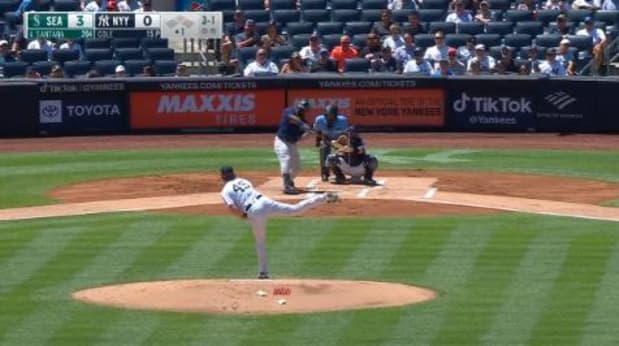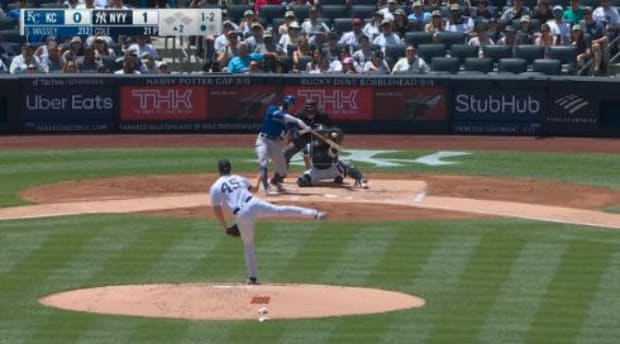The best pitcher never to have won a Cy Young Award is about to lose his bittersweet title. With four starts left (or five if he oddly pushes it), Gerrit Cole of the Yankees has the inside track to the AL Cy Young.
There is still time for Sonny Gray, his chief competitor, to make a run, as well as Kevin Gausman, Luis Castillo, George Kirby and Framber Valdez. But they will need Cole to fall to back of the pack, given that he leads the league in innings, ERA, winning percentage and WAR.
Cole (13–4, 2.90) has had bigger seasons—2015 and 2019 come to mind—but with Shohei Ohtani injured and no outlier seasons, the competition is breaking right for him this time. He has received Cy Young votes six times, including two runner-up finishes.
The Cy Young Award has been handed out in both leagues since 1967. Among pitchers who have made 250 starts since then, only Chris Sale has a higher ERA+ without winning the award. But Cole has more starts and wins than Sale, which make a case that he is the “Best Pitcher Never to Have Won a Cy.”
Highest ERA+ Since 1967, No Cy Young Award (Min. 250 GS)
| Pitcher | W-L | ERA | ERA+ |
|---|---|---|---|
1. Chris Sale |
120-78 |
3.10 |
138 |
2. Gerrit Cole |
143-75 |
3.20 |
129 |
3. Curt Schilling |
216-146 |
3.46 |
127 |
Roy Oswalt |
163-102 |
3.36 |
127 |
Kevin Brown |
211-144 |
3.28 |
127 |
So why now? Why, in his 11th season and about to turn 33 on Friday, is Cole finally in position to grab the Cy? Part of the story is the lack of a better argument, such as Justin Verlander in 2019 and Robbie Ray in 2021. Gray may lead Cole in FIP, but Cole leads Gray by 17 innings and 35 strikeouts with a lower WHIP and fewer walks.
Watch the Yankees with Fubo. Start your free trial today.
You may have heard about how Cole embraced the cutter midway through the season. Nice narrative—ace pitcher gets a new pitch!—but that’s a small reason why the award is his to lose. In order of importance, here are the reasons why this may finally be the year for Cole to grab the Cy Young:
1. Fastball command
Cole is throwing more four-seam fastballs than ever in his career. He conquered his home-run problem with the heater from last year when he left too many cookies in the middle of the plate.
He will tell you the foundation for his supreme fastball command began with his first “normal” spring training in four years. No COVID-19. No lockout. No World Baseball Classic by his own choice. A meticulous, routine-oriented pitcher, Cole found his groove in spring training—one walk and 27 strikeouts—and never looked back.
Look at the changes in his fastball metrics:
Cole Four-Seam Fastball
| Year | Pct. | MPH | Vert. Rel. | Ext. | Height | SLG |
|---|---|---|---|---|---|---|
2022 |
51.9% . |
97.8* |
5.78 |
6.5 |
2.52 |
420 |
2023 |
53.5%* |
96.7 |
5.95* |
6.3 |
2.85 |
.350 |
Pay attention to the average height of his fastball. Cole has one of the most efficient fastballs in the game, but it plays much better at the top and edges of the zone. By elevating his fastball more consistently, Cole reduced the slugging against it by 70 points.
2. Taking the “grunt” out of his fastball
Sandy Koufax famously found command of his fastball in a 1961 spring training road game when the major league staff stayed behind for a home game. Freed from trying to impress anyone, Koufax eased back on the throttle—he called it “taking the grunt out” of the pitch—and changed the course of his career.
In his own way, Cole has done the same this year. Look at that 2022-to-’23 fastball comparison again. He is throwing the pitch with less velocity, with less extension and from the highest release point of his career—and it’s a better pitch. The key to his improved fastball command is this throttling back of effort.
Let me show you what it looks like to throttle back just a little. Here are two Cole fastballs about a year apart:
August 3, 2022: Santana HR

July 22, 2023: Massey Strikeout

Those metrics discussed above are all evident here.
- Less extension: At release point last year, Cole’s trail foot is well off the pitching rubber. That’s the result of getting farther down the mound (or, put another way, getting out over the front side more). Think of it as generating more forward momentum. Look at the trail foot this year at ball release. It is just leaving the rubber. There is less “forward thrust” to generate velocity. He is letting go of the ball two to three inches closer to the rubber this year than he did last year.
- Higher release point: Compare the position of his head and hand at release. With less extension, he is more upright.
- Trading less velocity for more command: Not a big difference, but the fastball to Santana is 99 MPH and the one to Massey is 98 MPH. The key is the location. Major league hitters slug .564 against four-seam fastballs in the middle third of the strike zone. Get that same pitch a bit higher into the upper third of the zone, and their slug drops to .477.
By elevating the pitch from the middle to the top of the zone, Cole is missing barrels:
Pitch Locations
Pitch Locations
Pitch Locations


As for the red-line velocity, this is another way of measuring Cole’s throttling back:
| Year | Cole Fastballs 99+ MPH |
|---|---|
2022 |
257 |
2023 |
29 |
3. Workload
For the first time in seven years, Cole has not thrown more than 110 pitches in a game.
| Year | Cole Starts with 111+ Pitches |
|---|---|
2023 |
0 |
2022 |
5 |
2021 |
3 |
2020 |
1 |
2019 |
2 |
2018 |
4 |
2017 |
4 |
2016 |
0 |
2015 |
4 |
2014 |
2 |
He has faced only 22 batters when over 100 pitches, down from 38 last year. He also has pitched on only four days of rest 12 times, down from 17 last year.
4. The cutter
Ah, yes. The shiny new toy. Cole was 7–0 with a 2.82 ERA entering a June 9 start against Boston when he broke out eight cutters, two more than he had thrown in 13 starts to that point. He gradually has increased its use, though he is 6–4 with a 2.96 ERA since he started throwing it, so the effect of adding it is negligible.
Cole Cutter Use by Month, 2023
| Month | Pct. | Avg. |
|---|---|---|
April |
0.3% |
1.000 |
May |
0.3% |
.000 |
June |
7.2% |
.000 |
July |
9.2% |
.250 |
August |
16.8% |
.360 |
September |
8.7% |
.333 |
The cutter is a nice pitch to throw to get back into a count or show something inside to left-handed hitters. But let’s be real. It’s the worst of his five pitches. Batters are hitting .313 against it. He may throw a half dozen in a start. It’s not a game-changer. It’s just another tool in his toolbox.
Since Cole stepped on a big league mound in 2013, he ranks second among pitchers in strikeouts and third in wins, innings and starts. In 17 postseason games he is 10–6 with a 2.93 ERA, the ninth lowest ERA of all pitchers who made at least 15 starts. As he nears 300 career starts (he sits at 296), Cole’s career (143–75, 3.20) looks a lot like that of Randy Johnson at that threshold (143–79, 3.36).
Yet Cole’s reputation leans closer to reliable workhorse than it does to spectacular ace. That underestimation of his mark on the game may be about to change with four more starts—and one elusive award.







